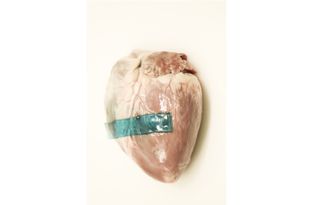Slug-Inspired Glue Patches Beating Hearts
The adhesive, described today (July 27) in a new study in the journal Science, sticks to wet surfaces, including the surface of a beating heart. It isn't toxic to cells, which gives it an advantage over many surgical glues. It's not available in operating rooms just yet — its developers say that could take years — but it could potentially be approved much more quickly for applications such as closing skin wounds.
The slug-inspired glue is "very stretchy and very tough," said Jianyu Li, a postdoctoral researcher at Harvard University's Wyss Institute for Biologically Inspired Engineering and the lead author of the study. Li and his colleagues applied the adhesive to a blood-soaked, beating pig heart and found that it worked better than any other surgical glue on the market.
Inspired by nature
The inspiration for the glue came from Arion subfuscus, a large and slimy species of slug found in North America and western Europe. These slugs excrete a sticky, yellow-orange slime that adheres well to wet surfaces. [7 Cool Technologies Inspired by Nature]

That characteristic intrigued Li and his colleagues, and they set to work making an artificial version of the slime. The key, Li told Live Science, is that the slime is made up of long, straight chains of molecules called polymers, which are also bound to each other — a phenomenon called cross-linking. Cross-linking makes materials strong, but the slug slime has the added advantage of having two types of cross-link bonds. Some were covalent bonds, which means they hold molecules together by sharing electrons. Others were ionic bonds, meaning one molecule hands over its electrons to another. These "hybridized" cross-links make the slug mucus both tough and stretchy, Li said.
The team mimicked this structure using artificial polymers layered onto what they called a "dissipative matrix." The polymers provide the sticking power, Li explained, while the dissipative-matrix layer acts like a shock absorber: It can stretch and deform without rupturing.
Patching wounds
To test the glue, the researchers applied it to pig skin, cartilage, arteries, liver tissue and hearts — including hearts that were inflated with water or air and covered in blood. The material proved extremely stretchable, expanding 14 times its original length without ever breaking loose from the liver tissue. When used to patch a hole in a pig heart, the adhesive maintained its seal even when it was stretched to twice its original length tens of thousands of times, at pressures exceeding normal human blood pressure.
The researchers even applied the adhesive to the beating heart of a real pig and found that the adhesion to the dancing, bloody surface was about eight times as strong as the adhesion of any commercially available surgical glue.
Sign up for the Live Science daily newsletter now
Get the world’s most fascinating discoveries delivered straight to your inbox.

The glue was also tested in a living rat: The researchers simulated an emergency surgery by slicing the rats' liver tissue and then patching the wound with either the glue or a standard blood-staunching product called Surgiflo. They found that the new adhesive was as good at stopping the blood flow as the standard glue; the rats treated with the new glue experienced no additional hemorrhaging up to two weeks after the surgery. The Surgiflo-treated rats, however, sometimes suffered from tissue death and scar tissue, the researchers reported. The rats treated with the slime-inspired glue did not experience these side effects.
Whether the new glue makes it to the operating room depends on much more extensive clinical testing, Li said, but the adhesive could make its debut as a new method of dressing external wounds on a shorter timeline than that.
"We have a company working on trying to push our material to clinical applications, and we have a patent pending," Li said.
Originally published on Live Science.

Stephanie Pappas is a contributing writer for Live Science, covering topics ranging from geoscience to archaeology to the human brain and behavior. She was previously a senior writer for Live Science but is now a freelancer based in Denver, Colorado, and regularly contributes to Scientific American and The Monitor, the monthly magazine of the American Psychological Association. Stephanie received a bachelor's degree in psychology from the University of South Carolina and a graduate certificate in science communication from the University of California, Santa Cruz.

